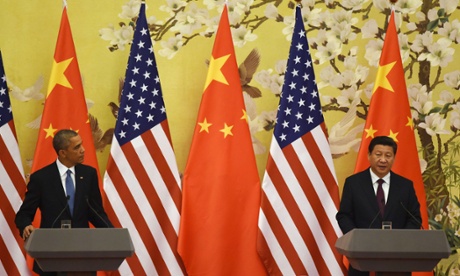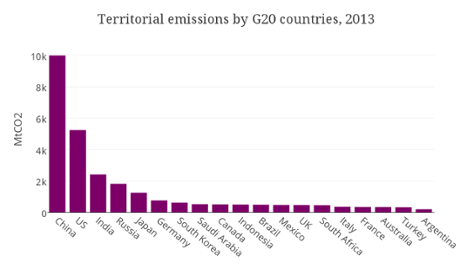China and US strike deal on carbon cuts in push for global climate pact
Barack Obama aims for reduction of a quarter or more by 2025, while Xi Jinping sets goal for emissions to fall after 2030

The United States and China have unveiled a secretly negotiated deal to reduce their greenhouse gas output, with China agreeing to cap emissions for the first time and the US committing to deep reductions by 2025.
The pledges in an agreement struck between President Barack Obama and his Chinese counterpart, Xi Jingping, provide an important boost to international efforts to reach a global deal on reducing emissions beyond 2020 at a United Nations meeting in Paris next year.
China, the biggest emitter of greenhouse gases in the world, has agreed to cap its output by 2030 or earlier if possible. Previously China had only ever pledged to reduce the rapid rate of growth in its emissions. Now it has also promised to increase its use of energy from zero-emission sources to 20% by 2030.
The United States has pledged to cut its emissions to 26-28% below 2005 levels by 2025.
The European Union has already endorsed a binding 40% greenhouse gas emissions reduction target by 2030.
Speaking at a joint press conference at the Great Hall of the People, Obama said: “As the world’s largest economies and greatest emitters of greenhouse gases we have special responsibility to lead the global effort against climate change. I am proud we can announce a historic agreement. I commend President Xi, his team and the Chinese government for their making to slow, peak and then reverse China’s carbon emissions.”
He said the US emissions reductions goal was “ambitious but achievable” and would double the pace at which it is reducing carbon emissions.
“This is a major milestone in US-China relations and shows what is possible when we work together on an urgent global challenge.”
He added that they hoped “to encourage all major economies to be ambitious and all developed and developing countries to work across divides” so that an agreement could be reached at the climate change talks in Paris in December next year.
China’s target to expand energy from zero-emission sources to around 20% by 2030 was “notable”, a White House statement said. “It will require China to deploy an additional 800-1,000 gigawatts of nuclear, wind, solar and other zero-emission generation capacity by 2030 – more than all the coal-fired power plants that exist in China today and close to total current electricity generation capacity in the United States.”
The new US goal will double the pace of carbon pollution reduction, although the Republican-controlled Congress is likely to oppose Obama’s climate change efforts, though administration officials argue the new target is achievable under existing laws.

Frances Beinecke, president of US-based environmental group the Natural Resources Defence Council, said: “These landmark commitments to curtail carbon pollution are a necessary, critical step forward in the global fight against climate change. We look forward to working with both governments to strengthen their efforts because we are confident that both can achieve even greater reductions.”
Senior US administration officials said the commitments, the result of months of dialogue between the world’s top two carbon emitters, would encourage other nations to make pledges and deliver “a shot of momentum” into negotiations for a new global agreement set to go into force in 2020.
Tao Wang, climate scholar at the Tsinghua-Carnegie Center for Global Policy in Beijing, said: “It is a very good sign for both countries and injects strong momentum [into negotiations] but the targets are not ambitious enough and there is room for both countries to negotiate an improvement.
“That figure isn’t high because China aims to reach about 15% by 2020, so it is only a five percentage point increase in 10 years, and given the huge growth in renewables it should be higher.”
Andrew Steer, president of the World Resources Institute, which promotes sustainable resource management, said the announcements would “inject a jolt of momentum in the lead up to a global climate agreement in Paris”.
“It’s a new day to have the leaders of the US and China stand shoulder to shoulder and make significant commitments to curb their country’s emissions,” he said.
Li Shuo, of Greenpeace East Asia, said the announcement showed that the world’s “two biggest emitters have come to the realisation that they are bound together and have to take actions together”.
At the Warsaw climate talks in 2013 nations were encouraged to draw up post-2020 climate plans by the first quarter of 2015, ahead of the final negotiations for a post-2020 global pact late in the year.
The White House statement said: “Together the US and China account for over one-third of global greenhouse gas emissions. Today’s joint announcement, the culmination of months of bilateral dialogue, highlights the critical role the two countries must play in addressing climate change.
“The actions they announced are part of the longer range effort to achieve the deep decarbonisation of the global economy over time. These actions will also inject momentum into the global climate negotiations on the road to reaching a successful new climate agreement next year in Paris.”
Source: http://www.theguardian.com/environment/2014/nov/12/china-and-us-make-carbon-pledge?CMP=EMCNEWEML6619I2
No comments:
Post a Comment